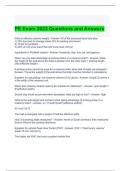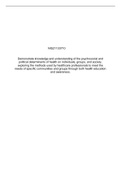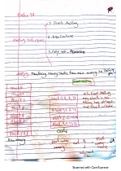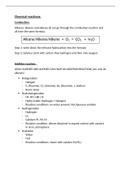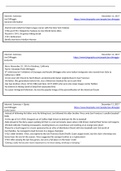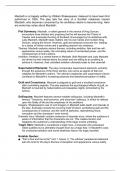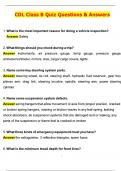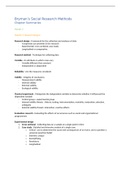Statistic 1b 6.3
Use and Abuse of Tests:
Each test is valid only in certain circumstances
AH: there is some effect or difference
NH: there is no difference
A low p-value presents good evidence that the research
hypothesis is true
The spirit of a test of significance is to give a clear statement
of the degree of evidence provided by the sample against the
null hypothesis
Statistically significant P ≤ 0.05
However, there is no sharp boarder b/w “significant” and “not
significant” only increasingly strong evidence as the P-value
decreases
“a scientific fact should be regarded as experimentally
established only if a properly designed experiment rarely fails
to give this level of significance.”
When large samples are available, even tiny deviations from
the null hypothesis will be significant
∝ =0.05 good evidence that an effect is present
statistical significance is not the same as practical significance
statistical significance rarely tells us about the importance of
the experimental results
“the foolish user of statistics who feed the data to a computer
without explanatory analysis will often be embarrassed”
o plot your data and examine it carefully, beware if
outliers
“absent of evidence is not evidence of absence!”
another important aspect of planning a study is to verify that
the test you plan to use does have high probability of
detecting an effect of the size you hope to find
tests of significance and confidence intervals are based on the
laws of probability
o randomization in sampling or experimentation ensures
that these laws apply
BUT we must often analyze data that do not arise from
randomized samples or experiments.
o To apply statistical inference to such data, we must have
confidence in a probability model for the data
The reasoning behind statistical significance works well if you
decide what effect you are seeking, design an experiment or
sample to search for it, and use a test of significance to weigh
the evidence you get
Many important discoveries have been made by accident
rather than by design
, You cannot legitimately test a hypothesis on the same data
that first suggested that hypothesis
P-values are more informative than the reject-or-not result
Very small p-values can be highly significant, especially when
based on a large sample
Lack of significance does not imply that the NH is true,
especially when the test has low power
Significance tests are not always valid! – faulty data collection,
outliers
Statistic Lecture 17
CI – values which we cannot reject
Almost always we have to use two-tailed tests
Errors
o You cannot argue for the NH when you just cannot reject
it
o You can only argue about difference if you tested for the
difference
Fix the sample size before the experiment!
Statistical significance does not imply practical significance!
Decide which type of test you use before looking at the data!
Stroop effect:
Ways to summarize and report results:
o Make a plot
o Absolute effect e.g.
o CI on the effect e.g.
o Statistical significance e.g.
o Standardized effect size – is an effect size scaled by the
amount of error in the data; this makes all effects
comparable, even ones with different units
Against a standard unit e.g. standard deviation
Cohen’s d
d=
signal-to-noise ratio
estimate of
Q – “How many population standard
deviation is my effect?”
Quantifies the effect size, does not depend
on N; z-score does depend on N
d has no units
d doesn’t change when units are changed
d is unaffected by linear transformation
Rule of thumb:
|d| ≈ 0.2 → small effect
|d| ≈ 0.5 → medium effect
|d| ≈ 0.8 → large effect
Use and Abuse of Tests:
Each test is valid only in certain circumstances
AH: there is some effect or difference
NH: there is no difference
A low p-value presents good evidence that the research
hypothesis is true
The spirit of a test of significance is to give a clear statement
of the degree of evidence provided by the sample against the
null hypothesis
Statistically significant P ≤ 0.05
However, there is no sharp boarder b/w “significant” and “not
significant” only increasingly strong evidence as the P-value
decreases
“a scientific fact should be regarded as experimentally
established only if a properly designed experiment rarely fails
to give this level of significance.”
When large samples are available, even tiny deviations from
the null hypothesis will be significant
∝ =0.05 good evidence that an effect is present
statistical significance is not the same as practical significance
statistical significance rarely tells us about the importance of
the experimental results
“the foolish user of statistics who feed the data to a computer
without explanatory analysis will often be embarrassed”
o plot your data and examine it carefully, beware if
outliers
“absent of evidence is not evidence of absence!”
another important aspect of planning a study is to verify that
the test you plan to use does have high probability of
detecting an effect of the size you hope to find
tests of significance and confidence intervals are based on the
laws of probability
o randomization in sampling or experimentation ensures
that these laws apply
BUT we must often analyze data that do not arise from
randomized samples or experiments.
o To apply statistical inference to such data, we must have
confidence in a probability model for the data
The reasoning behind statistical significance works well if you
decide what effect you are seeking, design an experiment or
sample to search for it, and use a test of significance to weigh
the evidence you get
Many important discoveries have been made by accident
rather than by design
, You cannot legitimately test a hypothesis on the same data
that first suggested that hypothesis
P-values are more informative than the reject-or-not result
Very small p-values can be highly significant, especially when
based on a large sample
Lack of significance does not imply that the NH is true,
especially when the test has low power
Significance tests are not always valid! – faulty data collection,
outliers
Statistic Lecture 17
CI – values which we cannot reject
Almost always we have to use two-tailed tests
Errors
o You cannot argue for the NH when you just cannot reject
it
o You can only argue about difference if you tested for the
difference
Fix the sample size before the experiment!
Statistical significance does not imply practical significance!
Decide which type of test you use before looking at the data!
Stroop effect:
Ways to summarize and report results:
o Make a plot
o Absolute effect e.g.
o CI on the effect e.g.
o Statistical significance e.g.
o Standardized effect size – is an effect size scaled by the
amount of error in the data; this makes all effects
comparable, even ones with different units
Against a standard unit e.g. standard deviation
Cohen’s d
d=
signal-to-noise ratio
estimate of
Q – “How many population standard
deviation is my effect?”
Quantifies the effect size, does not depend
on N; z-score does depend on N
d has no units
d doesn’t change when units are changed
d is unaffected by linear transformation
Rule of thumb:
|d| ≈ 0.2 → small effect
|d| ≈ 0.5 → medium effect
|d| ≈ 0.8 → large effect


